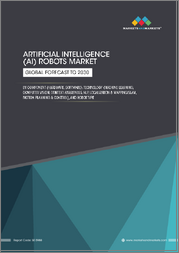
|
시장보고서
상품코드
1702312
로보틱스 시장 보고서 : 제품 유형별, 지역별(2025-2033년)Robotics Market Report by Product Type (Industrial, Service), and Region 2025-2033 |
||||||
로보틱스 세계 시장 규모는 2024년 532억 달러에 달했습니다. 향후 IMARC Group은 2033년에는 1,787억 달러에 달해 2025-2033년 연평균 성장률(CAGR)이 16.35%에 달할 것으로 예측하고 있습니다. 이 시장은 인공지능(AI)과 머신러닝(ML)의 급속한 기술 발전, 노동력 부족과 인건비 상승, 자동화 수요 증가, 다양한 정부 이니셔티브와 자금 투입, 응용 분야 확대 등으로 인해 급성장하고 있습니다.
로보틱스 시장 분석:
시장 성장과 규모 : 기술 발전, 다양한 산업 분야의 다양한 응용, 급성장하는 서비스 분야가 시장을 주도하며 안정적인 성장을 이루고 있습니다.
주요 시장 촉진요인 : 시장 성장에 영향을 미치는 주요 촉진요인으로는 인공지능(AI) 및 머신러닝(ML) 기술 발전, 노동력 부족 및 인건비 상승, 자동화 수요 증가, 정부의 노력, 응용 분야 확대 등을 꼽을 수 있습니다.
기술 발전 : AI, 센서 기술, 부품 소형화 등 최근 기술 혁신은 보다 복잡하고 효율적이며 정확한 작업을 가능하게 하여 시장 성장을 뒷받침하고 있습니다.
산업 용도 : 시장은 자동차, 제조, 의료, 농업, 국내 분야에서 로봇 공학에 대한 높은 수요를 경험하고 있습니다.
주요 시장 동향 : 주요 시장 동향으로는 AI를 강화하고, 인간과 로봇의 상호 작용을 개선하며, 자율 기능을 갖춘 로봇 개발로 전환하고 있다는 점을 들 수 있습니다. 또한, 특정 산업 수요에 맞는 로봇 솔루션의 맞춤화가 시장 성장을 견인하고 있습니다.
지리적 동향 : 아시아태평양은 중국, 일본 등의 국가에서 대규모 산업 자동화로 인해 시장을 주도하고 있습니다. 다른 지역도 로봇 품질의 급속한 혁신과 자동화 도입 확대에 힘입어 괄목할 만한 성장세를 보이고 있습니다.
경쟁 환경 : 시장의 특징은 기술 혁신, 전략적 파트너십, 세계 진출에 주력하는 대기업의 존재로 인해 급속한 기술 발전이 촉진되고 있습니다.
도전과 기회 : 시장은 로봇 시스템의 높은 초기 비용, 시스템 운영 및 유지보수를 위한 숙련된 전문가의 필요 등 다양한 도전에 직면해 있습니다. 그러나 규모의 경제를 통한 빠른 비용 절감과 사용자 친화적이고 적응성이 높은 로봇 시스템의 개발은 시장 성장의 새로운 기회를 창출하고 있습니다.
로보틱스 시장 동향:
급속한 기술 발전
인공지능(AI)과 머신러닝(ML)과 같은 첨단 기술의 통합으로 로봇이 환경으로부터 학습하고 새로운 작업에 적응하며 시간이 지남에 따라 성능을 향상시킬 수 있게 됨에 따라 시장 성장에 힘을 실어주고 있습니다. 또한, 최근 센서 기술의 발전으로 로봇의 인식 능력이 향상되어 주변 환경과 보다 효과적으로 상호 작용하고 더 높은 정확도로 복잡한 작업을 수행할 수 있게 된 것도 시장 성장에 긍정적인 영향을 미치고 있습니다. 이 외에도 전자부품의 소형화라는 새로운 트렌드는 더 작고 효율적이며 비용 효율적인 로봇 시스템의 시장 개척으로 이어져 시장 성장에 기여하고 있습니다. 이와는 별도로, 이러한 기술 혁신은 로봇의 기능성을 향상시킬 뿐만 아니라, 보다 광범위한 산업 분야에서의 활용을 가능하게 하여 시장 성장을 촉진하고 있습니다.
노동력 부족과 인건비 상승
많은 산업, 특히 전문 기술을 필요로 하는 산업과 열악한 환경에서 작업하는 산업에서 노동력 부족과 인건비 상승이 시장 성장을 촉진하고 있습니다. 이에 따라 로보틱스은 반복적이고 노동집약적인 작업을 자동화함으로써 효과적인 솔루션을 제공합니다. 또한, 노동력 부족에 직면했을 때에도 기업이 생산성 수준을 유지하는 데 도움이 됩니다. 또한, 로봇은 휴식 없이 연속적으로 작동할 수 있기 때문에 효율성과 생산량을 향상시킬 수 있습니다. 또한 로봇은 다양한 공정의 자동화를 촉진하여 기업이 인력에 대한 의존도를 줄이고 인건비 상승의 영향을 줄일 수 있습니다. 그 결과, 로봇은 제조, 물류, 농업 등 다양한 분야에서 널리 활용되고 있으며, 조립 및 포장부터 작물 수확 및 모니터링에 이르기까지 다양한 작업을 수행하고 있습니다.
증가하는 자동화 수요
제조, 헬스케어, 물류, 서비스 등 다양한 산업에서 효율성 향상, 비용 절감, 제품 및 서비스 품질 향상을 위한 자동화에 대한 수요가 증가하고 있는 것이 시장 성장의 원동력이 되고 있습니다. 이에 따라 로봇은 제조업에서 조립, 용접, 도장 등의 작업에 널리 사용되어 더 높은 정밀도와 생산성을 실현하고 있습니다. 또한, 헬스케어 분야에서는 수술, 재활, 환자 치료에 로봇을 도입하여 치료 성과와 효율성을 향상시키고 있습니다. 또한 물류 산업에서는 창고 관리, 분류, 운송 등의 작업에 로봇이 널리 활용되어 작업의 합리화, 속도 향상을 도모하고 있으며, 시장 성장을 강화하고 있습니다. 이 외에도 높아지는 소비자 수요에 대응하고, 경쟁 우위를 유지하며, 디지털화 및 상호연결된 세계에 적응하기 위해 자동화를 추진하려는 움직임이 지속되고 있는 것도 시장 성장을 촉진하고 있습니다.
다양한 정부 이니셔티브 도입
전 세계 각국 정부는 생산성, 경쟁력, 혁신을 촉진하는 로봇의 잠재력을 인식하고 있습니다. 이에 따라 각국 정부는 로봇 기술의 개발 및 채택을 지원하기 위해 다양한 노력과 자금 지원 프로그램을 시행하고 있습니다. 이러한 노력에는 연구 보조금, 세제 혜택, 로봇 공학에 투자하는 기업에 대한 공동 융자 옵션 등이 포함되는 경우가 많습니다. 또한, 정부는 로봇 기술을 발전시키기 위해 연구 기관과 대학에 자금을 지원하고, 새로운 애플리케이션을 개발하기 위해 산업계 파트너와 협력하고, 로봇 분야 스타트업에 재정적 지원을 제공하고 있습니다. 이러한 이니셔티브는 혁신을 촉진하고, 신기술 투자에 따른 재정적 위험을 줄이고, 기업이 로봇 솔루션을 채택하도록 장려하는 데 필수적입니다.
확장되는 응용 분야
로보틱스의 응용 분야 확대는 시장 성장에 크게 기여하는 요인입니다. 로보틱스은 지금까지 자동차 및 전자제품 제조에 많이 활용되어 왔습니다. 그러나 최근의 발전으로 심기, 제초, 수확과 같은 작업을 수행하는 농업과 같은 다양한 다른 분야에서도 많은 새로운 용도가 개척되어 효율성을 높이고 수작업에 대한 의존도를 낮추는 데 도움이 되고 있습니다. 또한, 로봇 공학은 의료 분야에서도 수술, 진단, 환자 재활에 활용되고 있습니다. 이 외에도 소매업과 접객업에서도 고객 서비스 및 운영 업무에 폭넓게 적용되고 있습니다. 이러한 새로운 분야로의 확장은 다양한 작업을 수행할 수 있는 최신 로봇 시스템의 다재다능함과 적응성이 원동력이 되고 있습니다.
목차
제1장 서문
제2장 조사 범위와 조사 방법
- 조사 목적
- 이해관계자
- 데이터 소스
- 1차 정보
- 2차 정보
- 시장 추정
- 상향식 접근
- 하향식 접근
- 조사 방법
제3장 주요 요약
제4장 소개
- 개요
- 주요 업계 동향
제5장 세계의 로보틱스 시장
- 시장 개요
- 시장 성장 촉진요인과 성공요인
- 시장 실적
- COVID-19의 영향
- SWOT 분석
- 밸류체인 분석
- Porter's Five Forces 분석
제6장 세계의 로보틱스 시장 : 제품 유형별
- 소개
- 산업용 로봇과 서비스 로봇
- 세계의 산업 로보틱스 시장
- 시장 개요
- 시장 내역 : 유형별
- 다관절 로봇
- 직교 로봇
- 스카라 로봇
- 원통형 로봇
- 기타
- 무역 데이터
- 세계의 서비스 로보틱스 시장
- 시장 개요
- 시장 내역 : 유형별
- 퍼스널 로봇 및 가정용 로보틱스 시장
- 프로페셔널 로보틱스 시장
- 시장 내역 : 용도별
- 가정용
- 엔터테인먼트 용도
- 방위 용도
- 필드 용도
- 물류 용도
- 헬스케어 용도
- 인프라 용도
- 모바일 플랫폼 용도
- 세정 용도
- 기타
제7장 세계의 로보틱스 시장 : 지역별
- 북미
- 시장 개요
- 시장 내역 : 제품 유형별
- 유럽
- 시장 개요
- 시장 내역 : 제품 유형별
- 아시아태평양
- 시장 개요
- 시장 내역 : 제품 유형별
- 라틴아메리카
- 시장 개요
- 시장 내역 : 제품 유형별
- 중동 및 아프리카
- 시장 개요
- 시장 내역 : 제품 유형별
제8장 경쟁 구도
- 시장 구조
- 시장 내역 : 주요 기업별
- 주요 기업 개요
The global robotics market size reached USD 53.2 Billion in 2024. Looking forward, IMARC Group expects the market to reach USD 178.7 Billion by 2033, exhibiting a growth rate (CAGR) of 16.35% during 2025-2033. The market is growing rapidly driven by rapid technological advancements in artificial intelligence (AI) and machine learning (ML), increasing labor shortages and rising labor costs, escalating demand for automation, imposition of various government initiatives and funding, and growing expansion in application areas.
Robotics Market Analysis:
Market Growth and Size: The market is witnessing stable growth, driven by technological advancements, diverse applications across various industries, and rapidly growing services segment.
Major Market Drivers: Key drivers influencing the market growth include technological advancements in artificial intelligence (AI) and machine learning (ML), labor shortages and rising labor costs, increasing demand for automation, government initiatives, and the expansion in application areas.
Technological Advancements: Recent innovations in AI, sensor technology, and miniaturization of components, enabling more complex, efficient, and precise operations, are supporting the market growth.
Industry Applications: The market is experiencing high demand for robotics in automotive, manufacturing, healthcare, agriculture, and domestic sectors.
Key Market Trends: The key market trends involve the ongoing shift towards the development of robots with enhanced AI, better human-robot interaction, and autonomous functionalities. Additionally, the customization of robotic solutions to meet specific industry needs is bolstering the market growth.
Geographical Trends: Asia Pacific leads the market due to massive industrial automation in countries, such as China and Japan. Other regions are also showing significant growth, fueled by rapid innovation in robot quality and growing adoption of automation.
Competitive Landscape: The market is characterized by the presence of major players who are focusing on innovation, strategic partnerships, and global expansion, which is fostering rapid technological advancements.
Challenges and Opportunities: The market faces various challenges, such as high initial costs of robotic systems and the need for skilled professionals to operate and maintain these systems. However, the rapid reduction in costs through economies of scale and the development of user-friendly and adaptable robotic systems are creating new opportunities for the market growth.
Robotics Market Trends:
Rapid technological advancements
The integration of cutting-edge technologies, such as artificial intelligence (AI) and machine learning (ML), which enable robots to learn from their environment, adapt to new tasks, and improve their performance over time, is propelling the market growth. Additionally, recent advancements in sensor technology, which have enhanced the perception abilities of robots, allowing them to interact more effectively with their surroundings and perform complex tasks with greater accuracy, are positively influencing the market growth. Besides this, the emerging trends of miniaturization of electronic components, leading to the development of smaller, more efficient, and more cost-effective robotic systems, are contributing to the market growth. Apart from this, these technological breakthroughs not only improve the functionality of robots but also make them more accessible to a broader range of industries, which is fueling the market growth.
Increasing labor shortages and rising labor costs
The increasing labor shortages and rising labor costs in many industries, especially those requiring specialized skills or operating in challenging environments, are propelling the market growth. In line with this, robotics offer an effective solution by automating repetitive and labor-intensive tasks. They can also help businesses maintain productivity levels, even in the face of labor shortages. Furthermore, robots can operate continuously without the need for breaks, leading to higher efficiency and output. Moreover, they facilitate the automation of various processes, thus allowing companies to reduce their reliance on human labor, thereby mitigating the impact of rising labor costs. As a result, robots are widely utilized in numerous sectors, such as manufacturing, logistics, and agriculture, to perform tasks ranging from assembly and packaging to crop harvesting and monitoring.
Escalating demand for automation
The increased demand for automation across various industries, such as manufacturing, healthcare, logistics, and services, to enhance efficiency, reduce costs, and improve product and service quality is driving the market growth. In line with this, robots are widely used in manufacturing for tasks like assembly, welding, and painting, enabling higher precision and productivity. Furthermore, they are adopted in the healthcare sector for surgeries, rehabilitation, and patient care, improving outcomes and efficiency. In addition, the widespread utilization of robots in the logistics industry for warehousing, sorting, and transportation tasks, streamlining operations, and enhancing speed is strengthening the market growth. Besides this, the ongoing push for automation, driven by the need to meet growing consumer demands, maintain competitive advantages, and adapt to an increasingly digital and interconnected world, is fueling the market growth.
Imposition of various government initiatives
Governments across the globe are recognizing the potential of robotics in boosting productivity, competitiveness, and innovation. In line with this, they are launching various initiatives and funding programs to support the development and adoption of robotic technologies. These initiatives often include research grants, tax incentives, and co-financing options for companies investing in robotics. Furthermore, governments are funding research institutions and universities to advance robotic technologies, collaborating with industry partners to develop new applications, or providing financial support to startups in the robotics sector. These initiatives are vital for fostering innovation, reducing the financial risks associated with investing in new technologies, and encouraging businesses to adopt robotic solutions.
Growing expansion in application areas
The expansion of application areas for robotics is a significant factor contributing to the market growth. Robotics has been heavily utilized in automotive and electronics manufacturing. However, recent advancements have opened up a plethora of new applications in various other sectors, such as agriculture, for tasks like planting, weeding, and harvesting, thus helping to increase efficiency and reduce the reliance on manual labor. Additionally, robotics is being adopted in the medical field for surgeries, diagnostics, and patient rehabilitation. Besides this, it finds extensive applications in the retail and hospitality industries for customer service and operational tasks. This expansion into these new areas is driven by the versatility and adaptability of modern robotic systems capable of performing a wide range of tasks.
Robotics Industry Segmentation:
Breakup by Product Type:
- Industrial
- Breakup by Type
- Articulated
- Cartesian
- SCARA
- Cylindrical
- Others
- Service
Breakup by Type
- Personal and Domestic
- Professional
- Breakup by Application
- Household Applications
- Entertainment Applications
- Defence Applications
- Field Applications
- Logistics Applications
- Healthcare Applications
- Infrastructure Applications
- Mobile Platform Applications
- Cleaning Applications
- Others
Service accounts for the majority of the market share
The service robotics segment holds the largest market share as it encompasses robots designed to assist humans and perform tasks in non-industrial settings. It includes applications in healthcare, logistics, agriculture, retail, and domestic use. Service robots are characterized by their versatility and ability to interact safely with humans and the environment. They assist in surgeries, patient care, rehabilitation, warehouse automation, inventory management, and delivery services. Moreover, the rapid expansion of the service segment, driven by technological advancements that have made service robots more affordable and capable, is driving the market growth.
The industrial robotics segment involves robots that are designed for tasks, such as assembly, welding, painting, and material handling. They are known for their precision, speed, and ability to perform repetitive tasks efficiently. These robots are widely utilized in industries, such as automotive, electronics, food and beverage (F&B), and heavy machinery.
Breakup by Region:
- North America
- Europe
- Asia Pacific
- Latin America
- Middle East and Africa
Asia Pacific leads the market, accounting for the largest robotics market share
The market research report has also provided a comprehensive analysis of all the major regional markets, which include North America, Europe, Asia Pacific, Latin America, and the Middle East and Africa. According to the report, Asia Pacific accounted for the largest market share.
The Asia Pacific region is the largest segment in the robotics market, owing to the extensive adoption of robots in manufacturing, particularly in the automotive and electronics industries. Additionally, the widespread utilization of industrial robots in countries like China to maintain production efficiency and quality is boosting the market growth. Furthermore, the presence of several countries in the region that are leaders in both the development and usage of robotics is positively influencing the market growth. Besides this, the increasing labor costs and the push towards automation to retain manufacturing competitiveness are contributing to the market growth.
The robotics market in North America is characterized by high technological adoption rates, significant investments in research and development (R&D), and a strong presence of leading robotics companies. Furthermore, the widespread use of robotics in manufacturing, especially in the automotive and electronics sectors, is catalyzing the market growth. Additionally, the increasing adoption in service industries, such as healthcare and logistics, is acting as another growth-inducing factor.
Europe is home to some of the world's leading robotic companies, particularly in industrial robotics, which is contributing to the market growth. Additionally, several regional countries are known for their engineering excellence and have a rich history in robotics, especially in the automotive and manufacturing sectors. Furthermore, the growing interest in service robotics, with applications expanding into healthcare, agriculture, and public services, is driving the market growth.
The Latin American robotics market is experiencing steady growth, driven by the increasing adoption of robotics in manufacturing. Additionally, the expanding automotive and food and beverage (F&B) industries in Latin America, which have been key adopters of robotic technology, using it to improve productivity and product quality, are supporting the market growth.
The robotics market in the Middle East and Africa region is showing signs of rapid growth, driven by the need to diversify economies. Additionally, the increasing shift from oil-dependent economies to technology and innovation-based industries in the region is positively influencing the market growth. Besides this, the expanding applications of robotics in sectors like construction, healthcare, and public services are favoring the market growth.
Leading Key Players in the Robotics Industry:
Key players are actively engaging in a variety of strategic initiatives to strengthen their market positions and respond to the evolving demands of the sector. They are heavily investing in research and development (R&D) to innovate and improve their robotic technologies. Additionally, several market leaders are expanding their global footprint through strategic partnerships, mergers, and acquisitions to accelerate the development and distribution of robotic solutions. Besides this, major companies are focusing on customizing their offerings to cater to specific industry needs, which involves close collaboration with clients to develop tailored solutions.
The market research report has provided a comprehensive analysis of the competitive landscape. Detailed profiles of all major companies have also been provided.
Key Questions Answered in This Report
- 1.What was the size of the global robotics market in 2024?
- 2.What is the expected growth rate of the global robotics market during 2025-2033?
- 3.What are the key factors driving the global robotics market?
- 4.What has been the impact of COVID-19 on the global robotics market?
- 5.What is the breakup of the global robotics market based on the product type?
- 6.What are the key regions in the global robotics market?
Table of Contents
1 Preface
2 Scope and Methodology
- 2.1 Objectives of the Study
- 2.2 Stakeholders
- 2.3 Data Sources
- 2.3.1 Primary Sources
- 2.3.2 Secondary Sources
- 2.4 Market Estimation
- 2.4.1 Bottom-Up Approach
- 2.4.2 Top-Down Approach
- 2.5 Forecasting Methodology
3 Executive Summary
4 Introduction
- 4.1 Overview
- 4.2 Key Industry Trends
5 Global Robotics Market
- 5.1 Market Overview
- 5.2 Key Market Drivers and Success Factors
- 5.3 Market Performance
- 5.3.1 Historical and Current Market Trends
- 5.3.2 Market Breakup by Product Type
- 5.3.3 Market Breakup by Region
- 5.3.4 Market Forecast
- 5.4 Impact of COVID-19
- 5.5 SWOT Analysis
- 5.5.1 Overview
- 5.5.2 Strengths
- 5.5.3 Weaknesses
- 5.5.4 Opportunities
- 5.5.5 Threats
- 5.6 Value Chain Analysis
- 5.7 Porter's Five Forces Analysis
- 5.7.1 Overview
- 5.7.2 Bargaining Power of Buyers
- 5.7.3 Bargaining Power of Suppliers
- 5.7.4 Degree of Competition
- 5.7.5 Threat of New Entrants
- 5.7.6 Threat of Substitutes
6 Global Robotics Market by Product Type
- 6.1 Introduction
- 6.1.1 Industrial Robots and Service Robots
- 6.1.2 Key Market Trends and Developments
- 6.2 Global Industrial Robotics Market
- 6.2.1 Market Overview
- 6.2.2 Historical and Current Market Trends
- 6.2.3 Market Breakup by Type
- 6.2.3.1 Articulated Robots
- 6.2.3.1.1 Historical and Current Market Trends
- 6.2.3.1.2 Market Forecast
- 6.2.3.2 Cartesian Robots
- 6.2.3.2.1 Historical and Current Market Trends
- 6.2.3.2.2 Market Forecast
- 6.2.3.3 SCARA Robots
- 6.2.3.3.1 Historical and Current Market Trends
- 6.2.3.3.2 Market Forecast
- 6.2.3.4 Cylindrical Robots
- 6.2.3.4.1 Historical and Current Market Trends
- 6.2.3.4.2 Market Forecast
- 6.2.3.5 Others
- 6.2.3.5.1 Historical and Current Market Trends
- 6.2.3.5.2 Market Forecast
- 6.2.3.1 Articulated Robots
- 6.2.4 Market Forecast
- 6.2.5 Trade Data
- 6.3 Global Service Robotics Market
- 6.3.1 Market Overview
- 6.3.2 Historical and Current Market Trends
- 6.3.3 Market Breakup by Type
- 6.3.3.1 Personal and Domestic Robots Market
- 6.3.3.1.1 Historical and Current Market Trends
- 6.3.3.1.2 Market Forecast
- 6.3.3.2 Professional Robots Market
- 6.3.3.2.1 Historical and Current Market Trends
- 6.3.3.2.2 Market Forecast
- 6.3.3.1 Personal and Domestic Robots Market
- 6.3.4 Market Breakup by Applications
- 6.3.4.1 Household Applications
- 6.3.4.1.1 Historical and Current Market Trends
- 6.3.4.1.2 Market Forecast
- 6.3.4.2 Entertainment Applications
- 6.3.4.2.1 Historical and Current Market Trends
- 6.3.4.2.2 Market Forecast
- 6.3.4.3 Defence Applications
- 6.3.4.3.1 Historical and Current Market Trends
- 6.3.4.3.2 Market Forecast
- 6.3.4.4 Field Applications
- 6.3.4.4.1 Historical and Current Market Trends
- 6.3.4.4.2 Market Forecast
- 6.3.4.5 Logistics Applications
- 6.3.4.5.1 Historical and Current Market Trends
- 6.3.4.5.2 Market Forecast
- 6.3.4.6 Healthcare Applications
- 6.3.4.6.1 Historical and Current Market Trends
- 6.3.4.6.2 Market Forecast
- 6.3.4.7 Infrastructure Applications
- 6.3.4.7.1 Historical and Current Market Trends
- 6.3.4.7.2 Market Forecast
- 6.3.4.8 Mobile Platform Applications
- 6.3.4.8.1 Historical and Current Market Trends
- 6.3.4.8.2 Market Forecast
- 6.3.4.9 Cleaning Applications
- 6.3.4.9.1 Historical and Current Market Trends
- 6.3.4.9.2 Market Forecast
- 6.3.4.10 Others
- 6.3.4.10.1 Historical and Current Market Trends
- 6.3.4.10.2 Market Forecast
- 6.3.4.1 Household Applications
- 6.3.5 Market Forecast
7 Global Robotics Market by Region
- 7.1 North America
- 7.1.1 Market Overview
- 7.1.2 Historical and Current Market Trends
- 7.1.3 Market Breakup by Product Type
- 7.1.4 Market Forecast
- 7.2 Europe
- 7.2.1 Market Overview
- 7.2.2 Historical and Current Market Trends
- 7.2.3 Market Breakup by Product Type
- 7.2.4 Market Forecast
- 7.3 Asia Pacific
- 7.3.1 Market Overview
- 7.3.2 Historical and Current Market Trends
- 7.3.3 Market Breakup by Product Type
- 7.3.4 Market Forecast
- 7.4 Latin America
- 7.4.1 Market Overview
- 7.4.2 Historical and Current Market Trends
- 7.4.3 Market Breakup by Product Type
- 7.4.4 Market Forecast
- 7.5 Middle East and Africa
- 7.5.1 Market Overview
- 7.5.2 Historical and Current Market Trends
- 7.5.3 Market Breakup by Product Type
- 7.5.4 Market Forecast
8 Competitive Landscape
- 8.1 Market Structure
- 8.2 Market Breakup by Key Players
- 8.3 Key Player Profiles



















